Environmental Law Quiz 1
1/69
There's no tags or description
Looks like no tags are added yet.
Name | Mastery | Learn | Test | Matching | Spaced |
|---|
No study sessions yet.
70 Terms
STEPS
stated policy scenario
more conservative
2100: 2.5 degrees C
APS & NZE
more defined goal of emissions
more ambitious
2100: 1.7 - 1.5 degrees C
NZE focus on clean energy
Private Environmental Governance (PEG)
private actions
firms
non-profits/NGOs
industry associations
ESG
Environmental social governance
Project Gigaton
Walmart 2010 commitment to reduce emissions
new goal in 2017 to reduce 1 billion tons by 2030
Helps suppliers find more renewable options & financings
Greenhushing
intentionally downplaying or withholding information about a company's genuine sustainability efforts
fear of backlash
Greenwashing
deceptive marketing practice where companies and organizations exaggerate or falsify their environmental credentials to appear more sustainable or environmentally friendly
Who should/can govern?
public actors
federal, state, local
non-traditional
courts
legislatures
regulatory agencies
private actors
What tools/instruments of governance are best under different circumstances?
prescriptive rules
market-leveraging instruments
informational governance
insurance
property rights
What ends should governance serve? Why govern?
efficiency
distributive justice
democratic participation
shareholder profit
shareholder welfare
stakeholder values
Royal Bank of Canada (RBC)
question of whether banks and other financial institutions should play a role in attempting to reduce/increase emissions
RBC financially backed oil-sands development in Alberta
Contrasts their commitment statement
major GHG emissions and waste of water
Rainforest Action Network (RAN)
passed statement to banks to limit emissions & unsustainable projects
reports, policy, goals
established a binding & uniform legal framework for banks to report on the CO2 emissions from their loans/investments
NGOs & stakeholders ability to file complaints on what they see as unacceptable transactions
Banks’ Arctic Financing Retreat
major U.S. banks pledged to stop financing new Arctic drilling projects
state governments responded with laws threatening to cut businesses with these banks
“net-zero banking retreat”: banks withdraw from climate alliances under pressure
Basic structure of U.S. Government
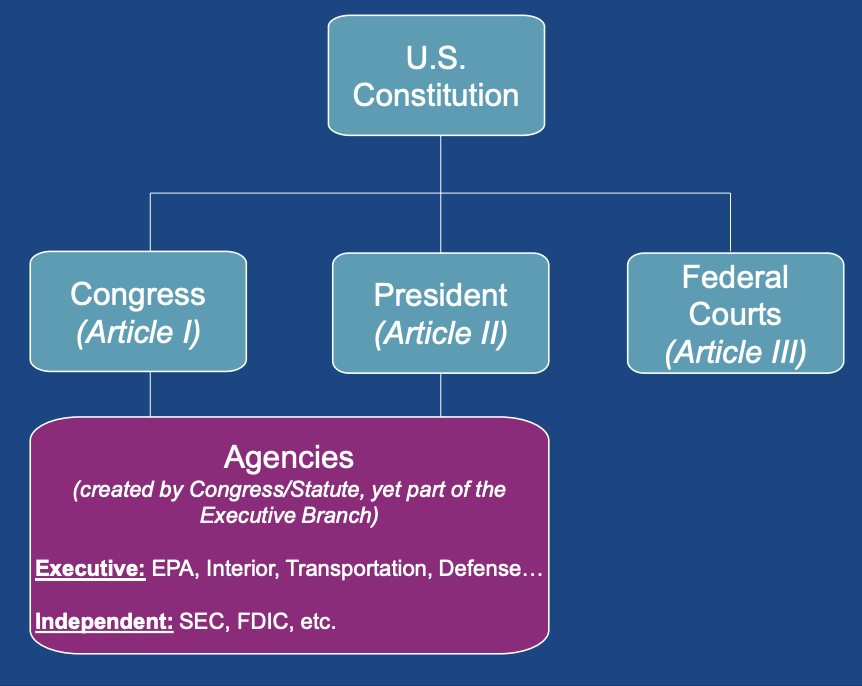
Executive Agencies
EPA
Interior
Transportation
Defense
cabinet level security, guide of president
Independent Agencies
SEC
FDIC
etc
many heads, appointed, harder to “rid” employees
Stare Decisis
latin for “let stand that which has been decided”
courts are bound by the legal rules announced in earlier cases by courts in controlling jurisdictions
SC can overrule precedent
no reopening case
U.S. (Federal) Court System
Supreme Court
Courts of Appeals
District Courts
U.S. Supreme Court
Writ of certiorari (legal order to review case) U.S. Courts of Appeals or State Supreme Court
Original jurisdiction over suits among states
U.S. Courts of Appeals
12 Regional Courts of Appeals (“Circuits”)
1 Court of Appeals for Federal Circuit
appeals from certain special courts
appeal as of right from U.S. District Courts
U.S. District Courts
94 Judicial Districts
Bankruptcy Courts
U.S. Court of International Claims
U.S. Court of Federal Claims
Geographic boundaries of Courts of Appeals and District Courts
circuit = region / geographic boundaries of court of appeals
SC handle disagreement in decisions by different circuits
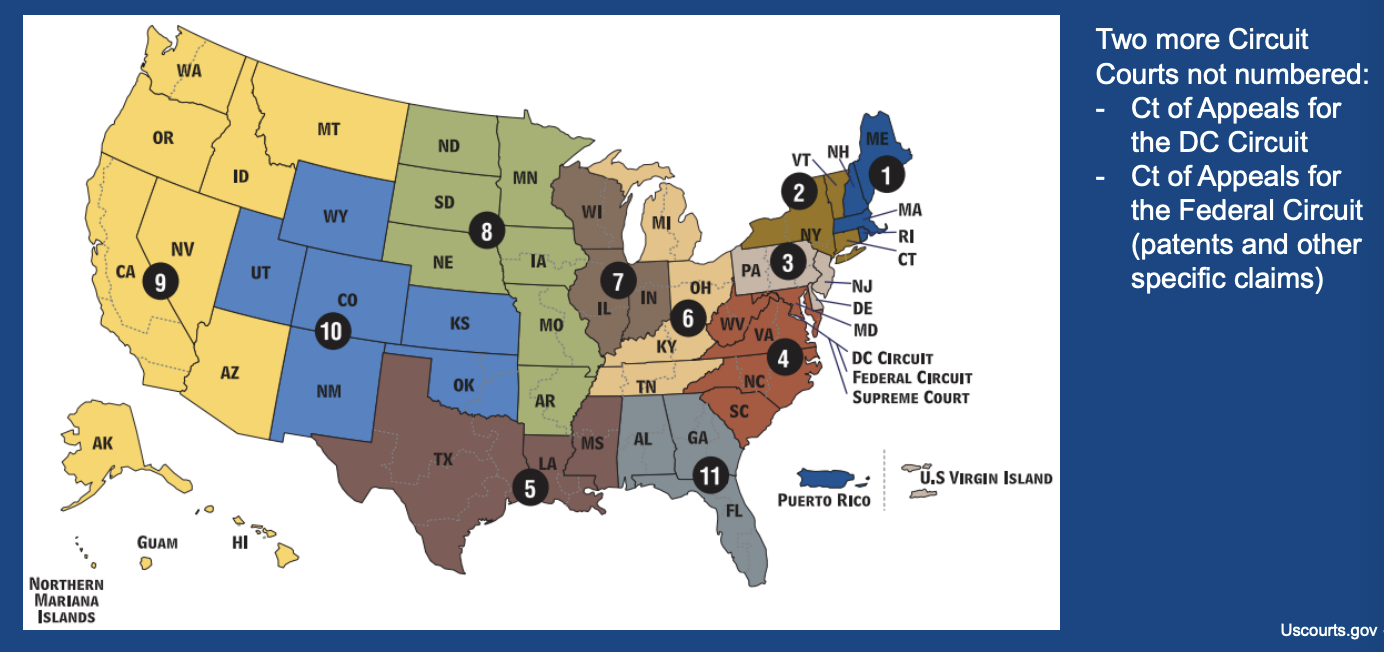
State Court System (hierarchy)
State Supreme Court
PA Supreme Court — 7 Justices
Intermediate Appellate Court(s)
PA Superior Court
PA Commonwealth Court
Trial Courts / Courts of General Jurisdiction
PA Courts of Common Pleas
Courts of Limited Jurisdiction, Municipal, Juvenile, Family Courts
PA Minor Courts
Anatomy of a Civil Lawsuit
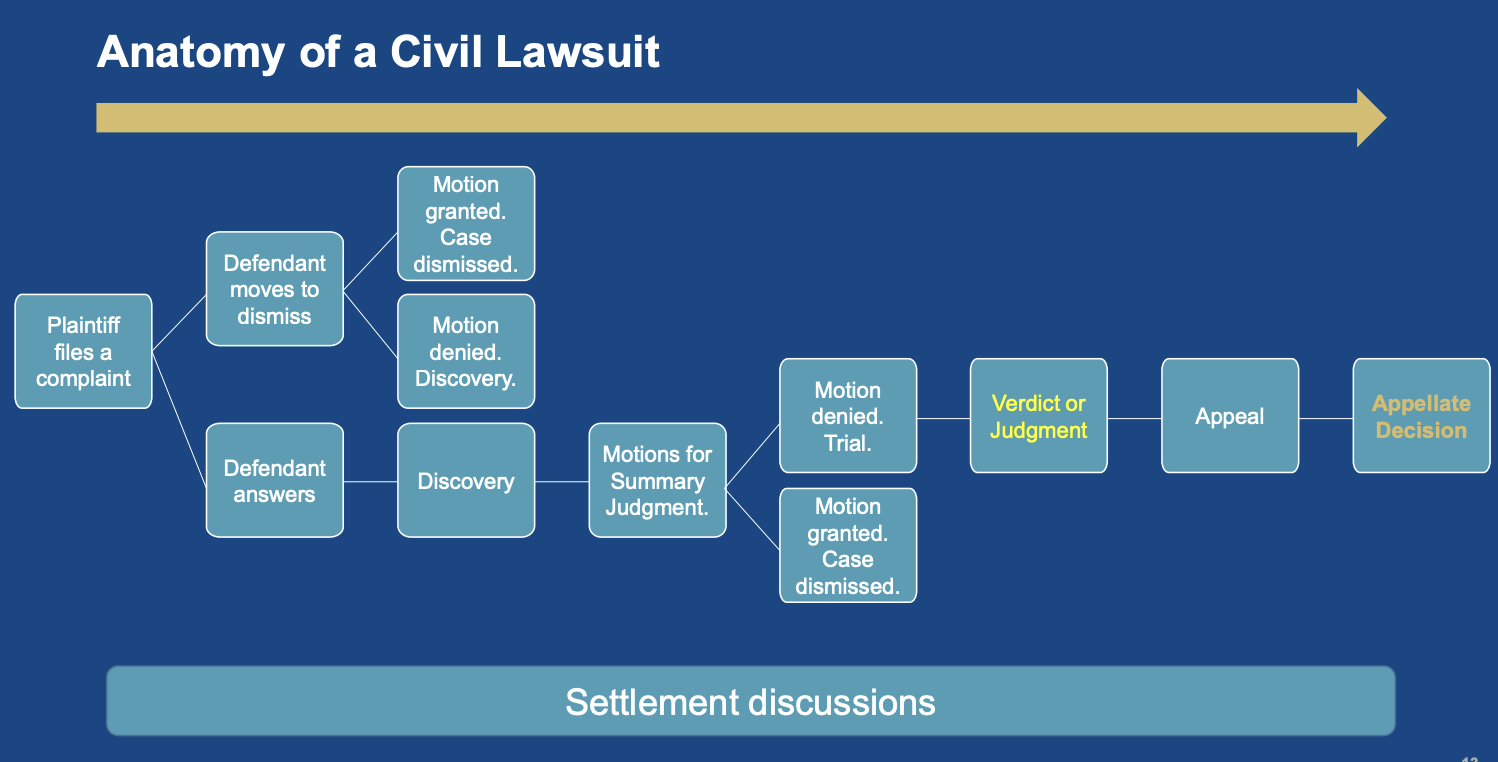
Civil cases vocab
Plaintiff files a suit
Complaint
Burden of Proof: Preponderance of the evidence
Settlements
Judgements
Money or Injunction
Criminal case vocab
Prosecutor files suit
Indictment or Information
Burden of Proof: Beyond a Reasonable Doubt
Plea Bargains
Verdict
Incarceration
Questions I will be asked / how to brief a case 1
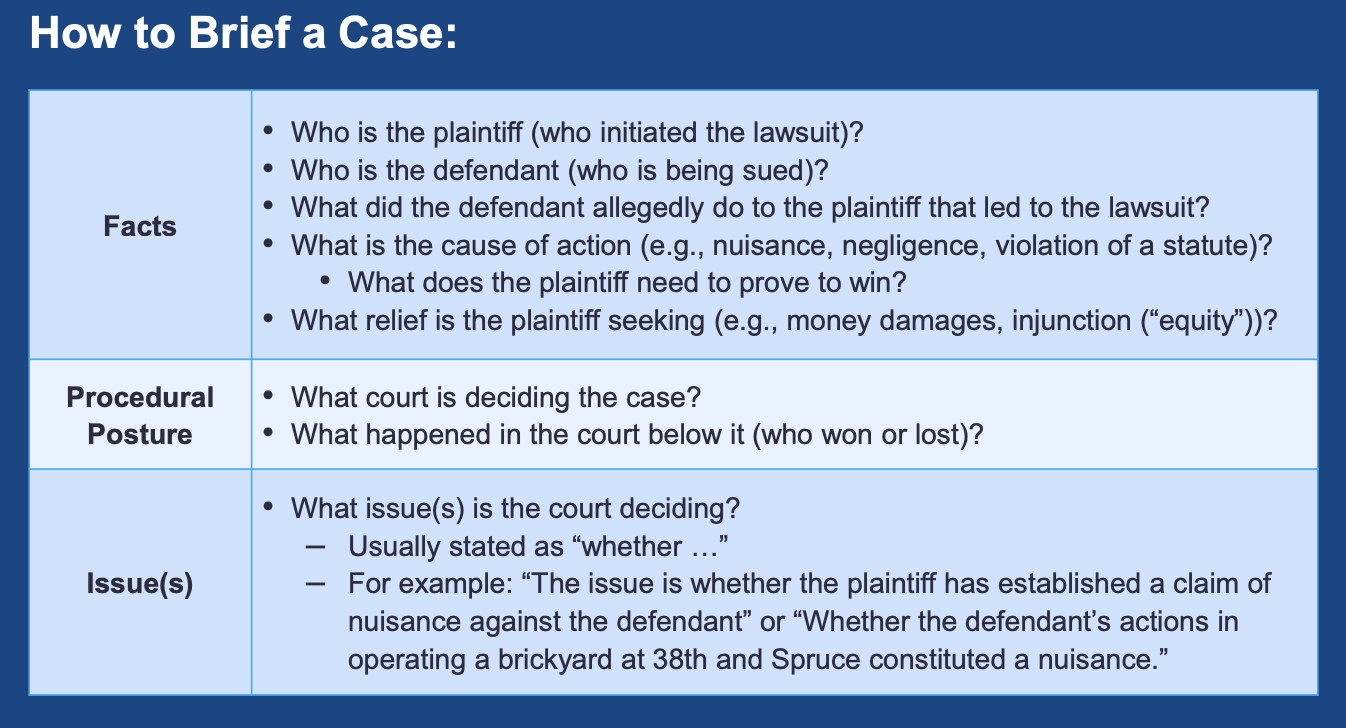
Questions I will be asked / how to brief a case 2
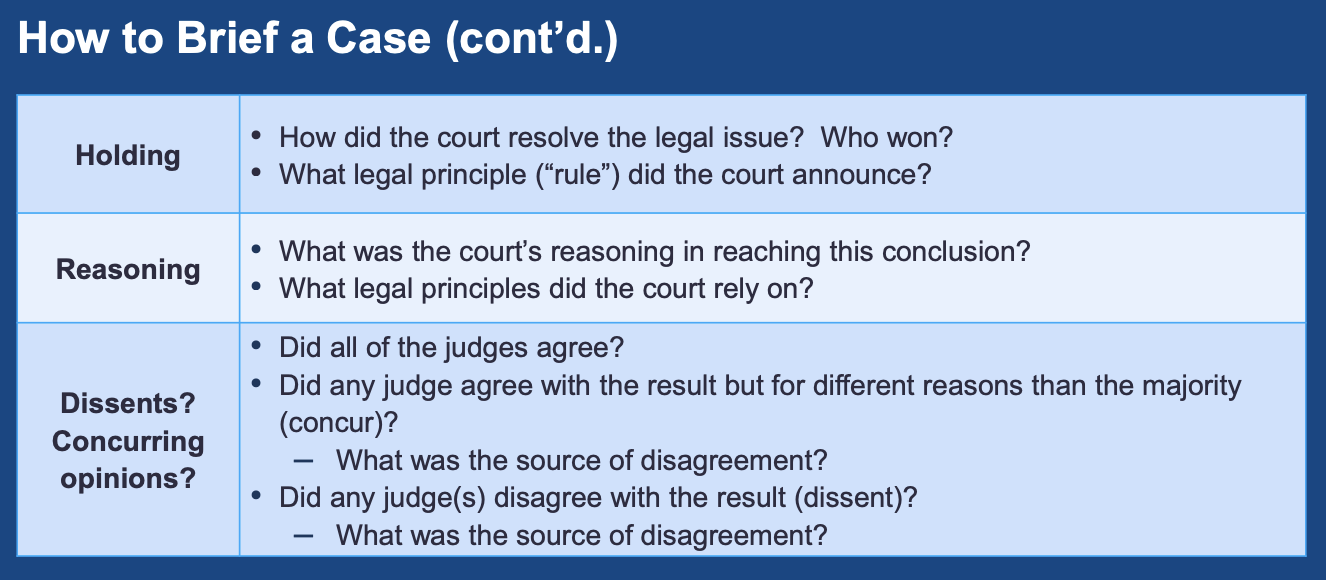
Edmunds V. Duff - Pa. 1924
Plaintiffs: Franklin Edmunds and other local homeowners
Defendants: Willow Grove Park Co., Philadelphia Rapid Transit Co., John Duff
Allegation: Defendants planned to build and operate a large amusement park in a quiet residential area
music pavilions
merry-go-rounds
swings, etc
Cause of Action: public nuisance
Relief Sought: Injunction to stop construction and operation of the amusement park
Procedural Posture: Court of Common Pleas (Delaware County) granted injunction to plaintiffs
Defendants appealed to the Supreme Court of Pennsylvania
Issue: Question of whether park constitutes a nuisance justifying an injunction
Holding: yes, nuisance —> injunction
Reasoning: evidence showed park’s noise would interfere with homeowners’ enjoyment of their property
Even before construction, there was a reasonable certainty of nuisance
Landowner cannot interfere with others’ enjoyment of their property
Madison V. Ducktown Sulfur, Copper & Iron Co. - Tenn. 1904
Plaintiffs: Madison and other local farmers/landowners
Defendants: Ducktown Sulphur, Copper & Iron Company, a large copper smelting operation in Tennessee
Allegation: Company’s smelters released sulfur dioxide fumes that destroyed crops, timber, and rendered land less valuable
Cause of Action: Private nuisance
Relief Sought: Injunction to stop the smelting operations and damages for harm caused
Procedural Posture: Tennessee trial court awarded monetary damages but refused to issue an injunction
Plaintiffs appealed, seeking an injunction to halt operations
Issue: Whether the court should enjoin the company’s copper smelting operations, despite proven nuisance and property damage
Holding: No injunction —> the court awarded money damages but allowed the smelters to continue operating
Reasoning: While the smoke clearly damaged plaintiffs’ land (a nuisance), shutting down the smelters would destroy a major regional industry and harm the broader public interest
The economic importance of the operations outweighed the private injury
“Balancing of hardships”
Hierarchy of Remedies
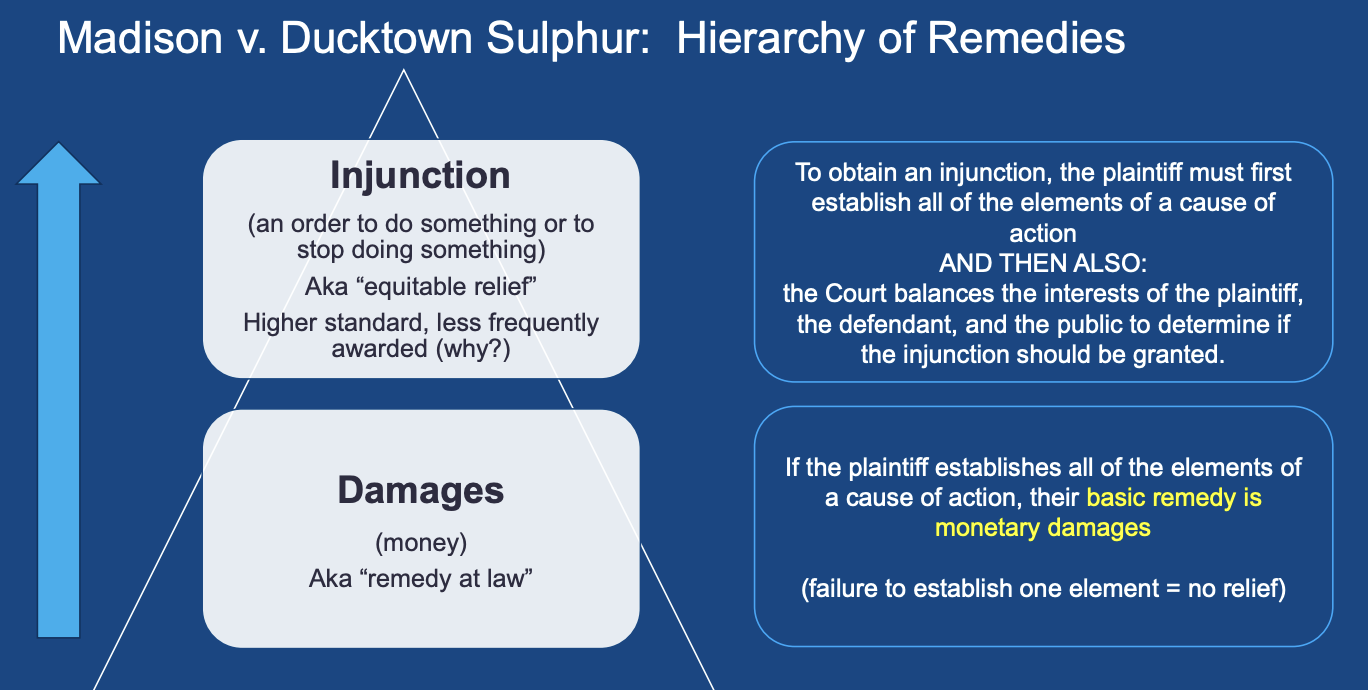
Private Nuisance
A wrongful invasion
Of a legal right or interest
Conduct is unreasonable or unlawful
Causation
Damage (harm)
Missouri V. Illinois - U.S. Supreme Court 1901 & 1906
Plaintiffs: State of Missouri
Defendants: State of Illinois and the Sanitary District of Chicago
Allegation: Chicago reversed the flow of the Chicago River through the new Sanitary & Ship Canal, sending untreated sewage into the Mississippi River system, which Missouri claimed polluted the Mississippi and endangered the health of St. Louis residents
Cause of Action: Public nuisance
Relief Sought: Injunction to stop Illinois from discharging sewage through the canal
Procedural Posture: Original jurisdiction case before the U.S. Supreme Court
Case argued first in 1901 on whether Missouri stated a valid claim; the Court allowed the case to proceed.
Final decision in 1906 after trial-like fact-finding
Issue: Whether Illinois’ discharge of sewage via the canal created a public health nuisance that justified the Supreme Court ordering an injunction
Holding: No injunction —> the Supreme Court held Missouri did not prove by clear and convincing evidence that Illinois’ sewage caused the alleged disease and harm in Missouri
Reasoning: Although Missouri showed pollution existed, the evidence was insufficient to directly link Illinois’ sewage to the typhoid outbreaks in St. Louis
The Court emphasized the need for clear and convincing proof when one state seeks to restrain another state’s public works
The decision stressed caution in using federal power to interfere with another state’s internal improvements without solid evidence
In interstate nuisance claims, a state must provide clear and convincing evidence of direct harm to obtain an injunction; mere suspicion or indirect correlation is insufficient for Supreme Court intervention
Public Nuisance
Involves a common right of the public to use or enjoy the land
elements of Cause of Action for Public nuisance:
an unreasonable interference with
the public’s right to use and enjoy land (“King’s highway”)
Causation
Damages/harm
Plaintiff can be either the government or private parties “uniquely affected” by the harm
Georgia V. Tenn. Copper, US Supreme Court 1907
Plaintiffs: State of Georgia
Defendants: Tennessee Copper Company and related copper smelters operating just over the border
Allegation: Sulfur dioxide fumes from the smelters drifted into Georgia, damaging forests, crops, and residents’ health
Cause of Action: Public nuisance
Georgia claimed harm to its environment and the welfare of its citizens
Relief Sought: Injunction to restrain the smelters from emitting harmful fumes into Georgia
Procedural Posture: Brought directly in the U.S. Supreme Court under its original jurisdiction
Georgia sought an injunction to stop the pollution
Issue: Whether the Supreme Court should grant an injunction against a private company in another state whose pollution was causing environmental damage across state lines
Holding: Yes —> The Court granted Georgia an injunction to limit the sulfur dioxide emissions
Reasoning: Justice Holmes emphasized that a state has quasi-sovereign interests in protecting the health and property of its citizens.
Georgia, as a sovereign, is not merely a private litigant; it may demand relief to safeguard its natural resources and the well-being of its people
The Court held that when one state’s activities cause proven harm to another state’s territory, federal equity can enjoin the conduct
The Supreme Court can issue an injunction to stop interstate environmental harm when a state shows a direct and substantial injury
Intergovernmental Panel on Climate Change (IPCC)
Founded 1988
Organized by the UN Environmental Program (UNEP) and World Meteorological Organization
Aim: Provide world with best scientific evidence on climate change
The Greenhouse Effect
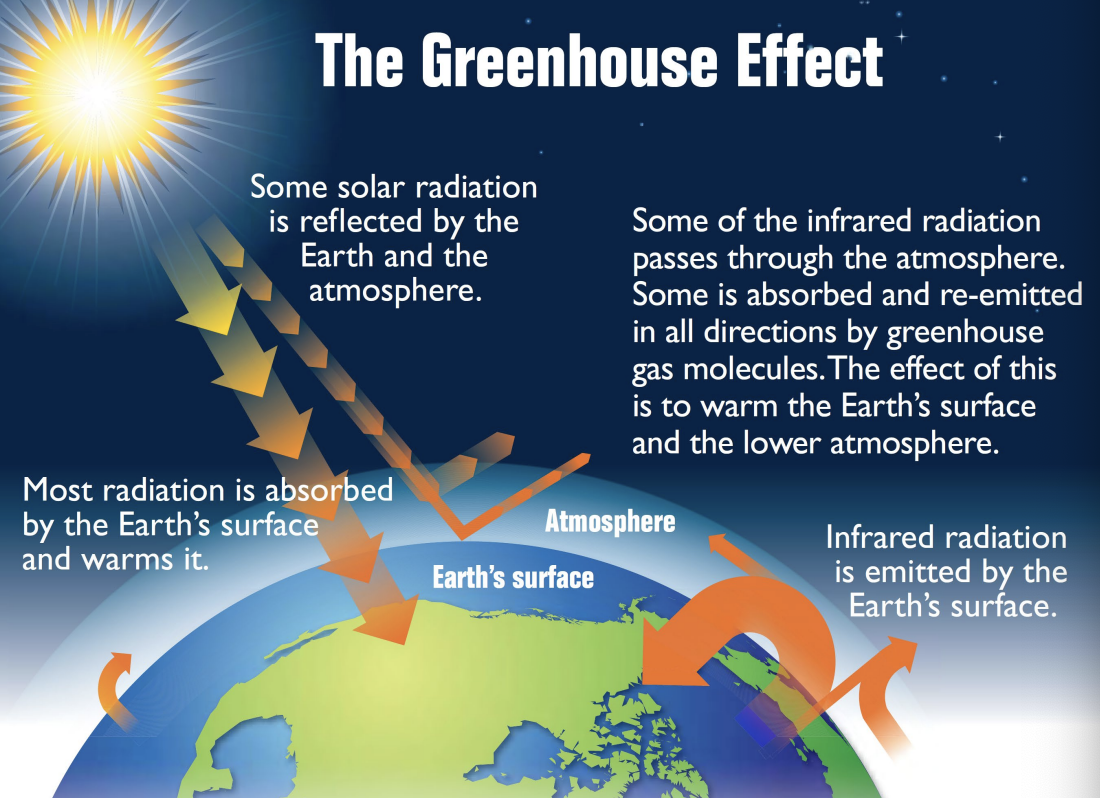
Greenhouse gas emissions
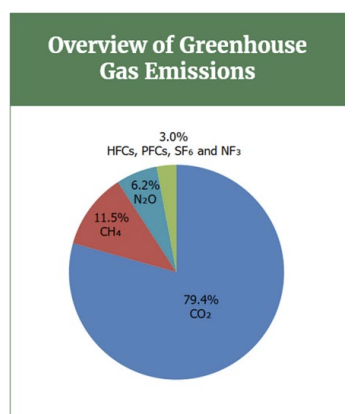
Greenhouse gas emissions by sector
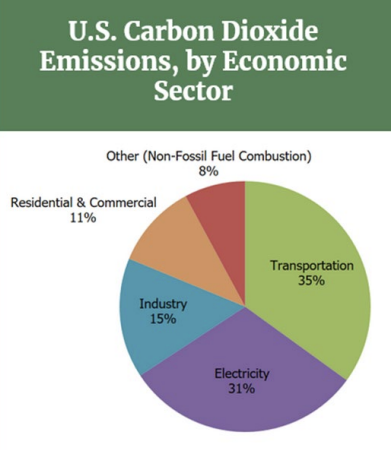
Climate science effects
Physical and biological systems
Increases in ocean acidification
Changes in polar temperatures
Changes in global precipitation
Sea level rise
More rapid than expected thawing of ice sheets in Arctic, Antarctic, and Greenland permafrost
Changing Climate in the Arctic
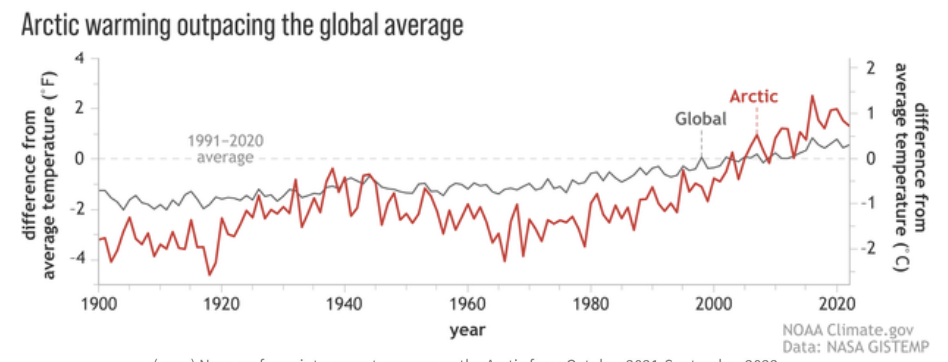
Kivalina V. ExxonMobil - 9th Cir. 2012
Plaintiffs: Native Village of Kivalina
Defendants: ExxonMobil and two dozen other major oil, energy, and utility companies
Allegation: Defendants’ greenhouse gas emissions contributed to global warming, which caused sea ice loss and severe coastal erosion, threatening the village’s existence
Cause of Action: Federal common law public nuisance
Relief Sought: Monetary damages to cover the cost of relocating the entire village
Procedural Posture: Federal district court dismissed the case
Ninth Circuit Court of Appeals affirmed dismissal
Issue: Whether plaintiffs could bring a federal common law public nuisance claim for damages against private companies for their contributions to climate change
Holding: No —> the Ninth Circuit held that the claim was barred
Reasoning: The Clean Air Act authorizes the EPA to regulate greenhouse gases; under American Electric Power v. Connecticut, this displaces federal common law nuisance claims about greenhouse gas emissions
Additionally, plaintiffs lacked standing: the alleged harms were too generalized and not “fairly traceable” to specific defendants in a way the courts could redress
Federal common law public nuisance claims for greenhouse gas emissions are displaced by the Clean Air Act
American Electric Power Co. v. Connecticut -U.S. Supreme Court 2011
Plaintiffs: Several states (including Connecticut, New York, and others), New York City, and three land trusts
Defendants: Major electric power companies (e.g., AEP, TVA)
Allegation: Defendants’ greenhouse gas emissions contributed to climate change and created a federal common-law public nuisance by causing widespread environmental harm
Relief Sought: Injunction requiring the utilities to cap and reduce carbon dioxide emissions
Procedural Posture: District court dismissed as a political question; Second Circuit reversed and allowed the suit
U.S. Supreme Court granted certiorari
Issue: Whether federal common-law nuisance claims can be used to force utilities to reduce greenhouse gas emissions, given the Clean Air Act
Holding: No —> the Clean Air Act displaces federal common-law nuisance claims regarding greenhouse gas emissions.
Reasoning: Congress delegated authority to the EPA to regulate greenhouse gases, and after Massachusetts v. EPA (2007) the EPA can set standards for CO2
When Congress provides a comprehensive statutory scheme, federal common law is displaced
Plaintiffs can instead pursue remedies through the EPA’s regulatory process
Once Congress creates a detailed regulatory framework for greenhouse gases, federal common-law public nuisance suits to control those emissions are barred
Hoboken V. Chevron Corp - 3rd Cir. 2022
Plaintiffs: City of Hoboken, NJ, and State of Delaware
Defendants: Major oil and gas companies including Chevron, ExxonMobil, and others
Allegation: Fossil fuel companies misled the public for decades about the risks of climate change, while their products drove rising seas and extreme weather, causing local damage
flooding
infrastructure harm
Claims: Public nuisance, trespass, consumer fraud, and related torts—seeking money damages and abatement costs
Relief Sought: Compensation and funding to mitigate climate-related harms
Procedural Posture: Oil companies removed the case from state court to federal court, arguing federal jurisdiction (because claims implicated federal common law and climate policy)
District court remanded to state court.
Defendants appealed to the Third Circuit
Issue: Whether the climate-damage lawsuits, framed under state law, should be heard in federal court
Holding: No —> tThe Third Circuit affirmed the remand to state court
Reasoning: The plaintiffs pleaded only state-law claims, and the defendants failed to show a valid basis for federal jurisdiction
The court rejected arguments that federal common law or federal officer removal automatically converts these claims into federal questions
Climate-related tort suits that are explicitly state-law based cannot be forced into federal court merely because they involve issues of interstate pollution or climate change
Suncor Energy V. Boulder, US SCT
Plaintiffs: City of Boulder
Defendants: Suncor Energy and other energy firms
Allegation: Defendants’ fossil-fuel production, marketing, and alleged deception about climate risks contributed to climate change, causing costly local impacts such as wildfires, drought, and flooding
Claims: Colorado state-law tort claims—public nuisance, trespass, unjust enrichment, and violations of the Colorado Consumer Protection Act
Relief Sought: Money damages and abatement funds to offset climate-related harms
Procedural Posture: Defendants sought to remove the case from Colorado state court to federal court, arguing federal jurisdiction
The federal district court remanded to state court
The Tenth Circuit affirmed the remand in 2022
Defendants petitioned the U.S. Supreme Court for certiorari
Issue: Whether these state-law climate-damage suits belong in federal court on the theory that they are inherently federal because they implicate interstate and international emissions regulation
Holding: The Tenth Circuit held removal was improper and affirmed that the cases belong in state court
Supreme Court denied certiorari
Reasoning: Plaintiffs carefully pleaded only state-law causes of action; federal common law does not automatically convert them to federal questions.
Defendants failed to show a valid federal jurisdictional hook
State-law climate tort suits can remain in state court even when they target global fossil-fuel emissions
Tragedy of the Commons
Individuals in the group receive a higher payoff for defecting than for cooperating, regardless of others’ choices
Higher total payoffs result from universal cooperation, but variation in who claims the value
Tragedy of the Commons Hardin’s Solutions
“Mutual coercion mutually agreed upon”
Privatize the commons (divide the land into parcels)
Coercive laws imposed by external “Leviathan” (Government control)
Population control
Tragedy of the Commons Ostrom’s Response
Pluralist: many solutions are possible
Insider solutions, self-regulation
Collective action: Clearly defined boundaries, monitoring (sometimes by insiders), conflict-resolution mechanism, graduated sanctions
Bicameralism
Both Chambers of Congress (House and Senate) must agree on the text
Presentment
The proposed law must be presented to the President to sign
Law by Congress
statutes
legislation
Law by President
executive orders
Law by Courts
Decisions
Judgments
Rulings
Agencies issue:
Regulations
“Rulemaking”
Agency interprets what the statue means when it adopts a regulation
Agency Rulemaking
governed by Administrative Procedure Act (APA)
To challenge, must comment then if dissatisfied by response, lawsuit

3 ways statute can settle legal standards (by Congress)
Sets standard itself
Expressly delegates standard-setting to an agency
Leaves gap/ambiguity
Chevron V. NRDC (1984)
Plaintiffs: Natural Resources Defense Council (NRDC) and other environmental groups
Defendants: Environmental Protection Agency (EPA) and Chevron U.S.A. (intervenor)
Allegation: EPA’s new rule interpreted “stationary source” under the Clean Air Act to mean an entire plant (“bubble concept”), letting companies treat all smokestacks in one facility as a single source.
Claims: Challenge to validity of EPA’s regulation under the Clean Air Act
Relief Sought: Invalidate EPA’s rule and require a stricter, smokestack-by-smokestack interpretation
Procedural Posture: D.C. Circuit struck down EPA’s “bubble” rule.
EPA and Chevron appealed to the U.S. Supreme Court
The Tenth Circuit affirmed the remand in 2022
Issue: Whether the term “stationary source” refers to each smokestack or the whole facility, and whether courts must defer to EPA’s interpretation when the statute is ambiguous
Holding: The Supreme Court upheld EPA’s “bubble” interpretation and established the principle of Chevron deference
Reasoning: Created a two-step framework:
If Congress has spoken clearly, courts must follow Congress’s intent.
If the statute is ambiguous, courts defer to the agency’s reasonable interpretation.
The Clean Air Act’s definition of “stationary source” was ambiguous, and EPA’s “bubble” rule was a reasonable policy choice
Chevron deference: When Congress leaves a statutory gap or ambiguity, a reasonable agency interpretation controls, even if a court might prefer another reading
Loper-Bright V. Raimondo (S. Ct. 2024)
Plaintiffs: Loper Bright Enterprises and other family-owned fishing companies
Defendants: U.S. Secretary of Commerce (Raimondo) and the National Marine Fisheries Service (NMFS)
Allegation: NMFS required certain Atlantic herring vessels to pay the salaries of federal observers who monitor fishing activities for compliance with federal law
Claims: Plaintiffs argued the Magnuson-Stevens Fishery Conservation and Management Act does not authorize NMFS to force industry to fund federal observers
Relief Sought: Invalidate the NMFS rule and stop the agency from imposing the cost
Procedural Posture: D.C. Circuit upheld NMFS’s rule, applying Chevron deference to the agency’s interpretation of the statute.
Supreme Court granted certiorari to consider whether to overrule or limit Chevron
Issue: Whether Chevron deference should continue to govern when courts review agency interpretations of ambiguous statutes
Holding: The Supreme Court overruled Chevron. Courts must independently interpret statutes without deferring to an agency’s view simply because the statute is ambiguous
Reasoning: Statutory interpretation is the duty of the judiciary under Article III; courts may consider an agency’s expertise for guidance but cannot abdicate their role
Deference under Chevron allowed agencies to effectively make law, undermining separation of powers
Agencies can still receive respect (Skidmore deference) when their reasoning is persuasive, but not automatic controlling weight
Chevron deference is no longer controlling: Courts now interpret ambiguous statutes de novo, giving agency interpretations only whatever persuasive weight they deserve
Salzman’s Five P’s
Prescriptive Regulation
Property Rights
Financial Penalties
Financial Payments
Persuasion
Caption
case title
Case citation
letters/numbers indicating the court, reporter, and year
Concurring opinion (concurrence)
judge agrees with the outcome but uses different reasoning
Dissenting opinion (dissent)
judge disagrees with the majority’s decision
Appeal
legal proceeding reviewing a lower court’s decision
Appellant
losing party in lower court, filing the appeal
Remand
send case back to lower court for further proceedings
Vacate
nullify lower court decision
Common Law
body of judicial decisions, derived from English law
Holding
the essential rule of law necessary to decide the case
Dicta
statements not essential to the ruling; commentary “by the way”